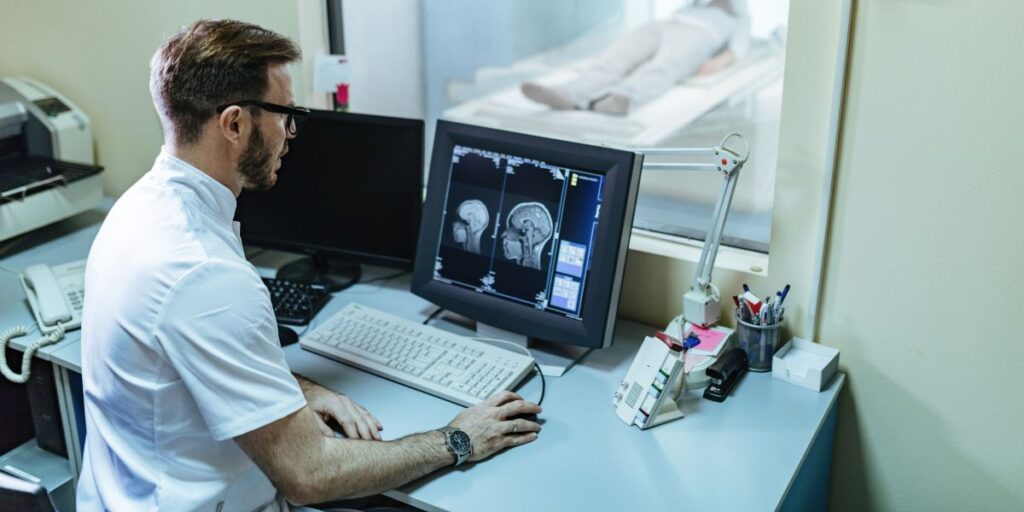Understanding RIS/EMR and PACS Integration

Within the dynamic landscape of modern healthcare, radiology departments are continuously looking for innovative solutions to enhance their operational efficiency. At the forefront of this transformation are two indispensable technologies: radiology information systems (RIS) and picture archiving and communication systems (PACS). The integration of RIS/EMR and PACS has ushered in a new era in radiology workflow management, offering a seamless synergy that unlocks a host of invaluable benefits.
Radiology Information System (RIS)/Electronic Medical Records (EMR)
A radiology information system (RIS)/Electronic Medical Records is a software solution designed specifically for radiology departments to manage various aspects of radiology operations, and ensure the department’s operating at the highest level possible. RIS encompasses several features and functions, including:
Patient Information Management
RIS/EMR maintains comprehensive patient records that include demographic data, medical history, referring physician information, and other relevant patient details.
Scheduling and Appointments
RIS/EMR assists in scheduling radiology procedures and appointments for patients, ensuring efficient use of resources and proper allocation of time slots.
Order Entry and Tracking
It allows physicians to place orders for specific radiology procedures and track the progress of those orders. This ensures that the right tests are conducted for each patient and that the results are properly documented.
Workflow Management
RIS/EMR helps manage the workflow within the radiology department by coordinating tasks such as patient check-in, exam preparation, image acquisition, image interpretation, and report generation.
Picture Archiving and Communication System (PACS):
PACS revolutionized the management of medical images by transitioning them from traditional film-based systems to digital storage solutions. Its primary purposes include the storage, retrieval, and distribution of medical images and related data.
Integration of RIS/EMR and PACS:
The integration of RIS/EMR and PACS combines the strengths of both systems to create a unified workflow for radiology departments. The integration process involves:
- Sharing patient information and scheduling data from RIS/EMR to PACS.
- Associating acquired images with patient and examination details from RIS/EMR.
- Linking generated reports from RIS to corresponding images in PACS.
Integration typically occurs through standard communication protocols, such as Health Level 7 (HL7) and Digital Imaging and Communications in Medicine (DICOM).
Integrating RIS/EMR and PACS offers several advantages to your radiology department:
Streamlined Workflow
Integration eliminates the need for duplicate data entry and manual transfers between systems. It automates processes and ensures patient information and images are seamlessly shared between RIS/EMR and PACS, minimizing the potential for errors and reducing administrative burden.
Enhanced Image Access and Distribution
Integration allows radiologists to access patient images directly from the RIS/EMR, eliminating the need to switch between multiple systems. This improves productivity and enables faster diagnoses and treatment decisions.
Improved Reporting and Documentation
Integration facilitates the automatic transfer of radiology reports from PACS to RIS/EMR, ensuring accurate documentation and reducing reporting delays. This improves communication between radiologists and referring physicians, contributing to better patient care and outcomes.
Aspyra the Leading PACS Provider
If you are looking to enhance your radiology workflow and improve patient care with the integration of RIS/EMR and PACS, Aspyra can seamlessly integrate with your existing RIS/EMR system. By partnering with Aspyra, you can optimize your radiology department’s workflow without the need to replace your current RIS/EMR system. Aspyra’s expertise and cutting-edge technology can revolutionize your radiology operations and seamlessly integrate with your existing systems. Choose Aspyra as your trusted partner for enhancing your radiology workflow and revolutionizing your operations while maximizing the efficiency of your existing RIS/EMR system.

